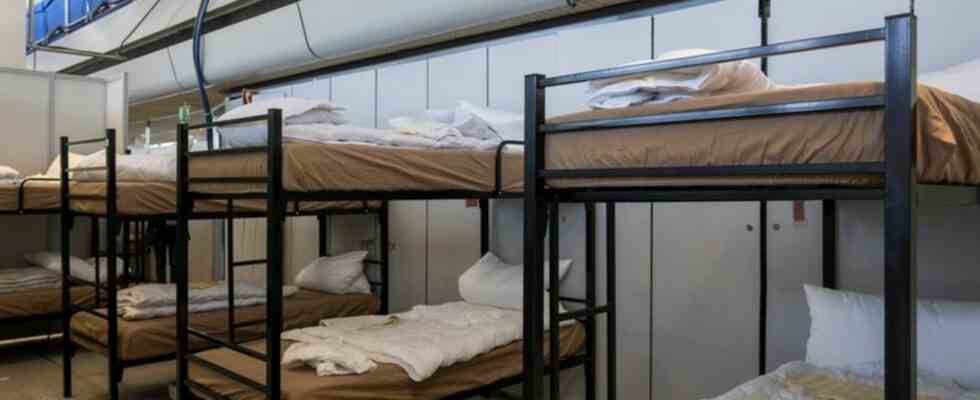war refugees
New life at the old Tegel Airport
Bunk beds in a separate area in the main terminal of the former Berlin Tegel Airport. Photo: Monika Skolimowska/dpa-Zentralbild/dpa
© dpa-infocom GmbH
Tegel Airport finally went offline almost a year ago – but there is no sign of a slumber. During the crisis, its striking buildings become a place of refuge for war refugees from Ukraine.
“Toiletries” or “animal food” is written on the white slips of paper stuck to the check-in counter. Others have breakfast, lunch, and dinner times written in English.
Large vacuum flasks with water or coffee and tea stand on metal trolleys. Children’s pictures are stuck to the glass panes of the improvised play area and a corona test area. A woman walks down the aisle in Terminal A with her dog on a leash. The former Tegel Airport has been revived for a week. Where once airline passengers waited at the gate, there are now separate rooms, each with five bunk beds.
700 beds are available
“In three days we woke Tegel from its slumber,” says Detlef Cwojdzinski, project manager of the new Ukrainian arrival center TXL. No sooner had the infrastructure at the old main terminal of the airport – such as the fresh water supply – started up again than the first 425 refugees stayed here, including 105 children. Since then, the number of beds has grown steadily and is now around 700. Two legs of the hexagonal Terminal A are already occupied, and others will follow.
Because the Berlin Senate continues to expect thousands of people to come to Berlin every day. Their accommodation and care at Tegel Airport should be as professional as possible – with the help of a new distribution center, among other things. The Governing Mayor Franziska Giffey (SPD) announced on Tuesday that this should go into operation at the end of the week. According to the social administration, an exact date has not yet been set. “We open as soon as possible,” said spokesman Stefan Strauss on Friday.
Three tents have been erected on the runway over the past few days. It is planned to register up to 10,000 arriving refugees in the center every day and to make a binding decision as to which federal states they will travel to. Several hundred employees are needed for this, including 80 Bundeswehr soldiers to help. According to the project management, the processes were rehearsed on Friday with the refugees who arrived.
So far about 6500 people have registered
The State Office for Refugee Affairs (LAF) relies on the new distribution center: “Then we will be able to register and distribute many more people who are currently still being accommodated in the LAF’s temporary and regular accommodation because otherwise they would not have a roof over their heads », according to spokeswoman Monika Hebbinghaus. According to rough estimates, around 6,500 people who have actively reported have been registered since March 7th.
With the new structures in Tegel, refugees who are traveling on should not even enter the airport building. Three more tents have been erected on the runway. “People are looked after there and can – if necessary – sleep before they continue,” explains the spokeswoman for the arrival center, Regina Kneiding.
Dogs and cats are also allowed to stay
People staying in the capital will initially be accommodated in Terminal A. People should stay in Tegel for a maximum of two to three days. First, a rapid corona test is carried out, followed by a short medical screening. If you are healthy and do not need any further care, you will be allocated a bed. Dogs and cats are also allowed to stay. Where there used to be shops in the terminal, there is now an animal station that is looked after by the animal shelter and animal welfare association.
As with the Berlin vaccination centers, the German Red Cross (DRK) is responsible for project management at the closed airport. For the implementation, the organization brought the 67-year-old Cwojdzinski out of retirement again. The former crisis manager of the Berlin health administration was already involved in setting up the vaccination centers in 2020. His tasks include recruiting staff and coordinating the aid organizations involved, the Arbeiter-Samariter-Bund, DLRG, Johanniter and Malteser. In addition to housing, each has another task.
“I didn’t want to do such a big project anymore,” says the 67-year-old. But in view of his experiences and contacts, it was clear to him that he could not say no. He feels the same way as the long-standing President of the Federal Agency for Technical Relief, Albrecht Broemme. The 68-year-old has taken over the coordination of the Ukrainian war refugees in Berlin for the Senate – after he had managed the construction of the emergency hospital on the exhibition grounds during the corona pandemic and then coordinated the construction of the vaccination centers in the capital.
Vaccination Center in Terminal C
“We now have a wealth of experience. Structures, processes – and the people for them. That’s the be-all and end-all,” explains the project manager. “I draw a lot from the vaccination concept here,” he explains, looking at the disused airport site. The vaccination center, which opened in February 2021 and is currently used in particular for child vaccinations, is still in operation in Terminal C just a few meters away. Up to 100 people still come there every day, reports spokeswoman Kneiding.
After more than a year, the center is in “regular operation” – while several hundred people are still active in the construction team in the neighboring arrival center. “We have to manage solid operations. From emergency mode to regular operation,” emphasizes Cwojdzinski. At the moment, he cannot say how quickly this will happen. But the pensioner also wants to achieve this quickly in his own interest.

